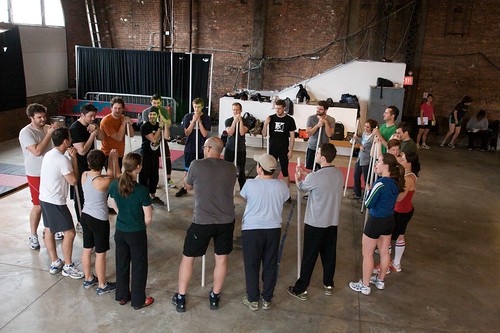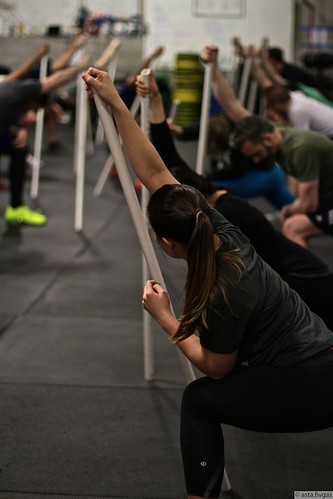How to Run Large Group Classes at CrossFit Affiliates Part 2
 Monday, May 5, 2014 at 12:00AM
Monday, May 5, 2014 at 12:00AM 
Last week, we discussed some practices and principles that help CFSBK run larger classes in the most effective, efficient, and professional manner possible. We discussed the importance of clarity and how to leverage your coaches in each class. Today, we’ll focus on how programming can create a better management situation in group classes, and share a few strategies about how to run certain workouts and maximize the utility of your space. We’ll also address the pros and cons of requiring pre-registration.
 Level the Programming
Level the Programming
Larger classes also mean you will confront a broader range of capacities, available skill sets, and levels of experience, all at once. This inherently makes running an effective class for everyone more challenging. In a previous article, I talked in detail about the benefits of leveled programming and why we use it at CFSBK. Another benefit of leveled programming that I didn’t address in that article is that it increases your flow options for your classes.
Until very recently at CFSBK, everyone performed the coach-led Olympic lifting barbell warm-ups together before the open lifting segment (we made a video demonstrating this). CFSBK’s coaching staff realized in the last few months that our more experienced athletes needed more time to get to heavier weights and didn’t necessarily need to review the movements at a level that newer athletes did. So we made an adjustment and split up how we run the lifts. The folks following Fitness programming still get our barbell review and warm-up led rep-by-rep with one coach, which review basic positions and the intentions of each drill or complex. Those following Performance programming perform a more abbreviated barbell warm-up complex at their own pace before transitioning into progressively loading their bar. If the total Olympic lifting segment takes 25 minutes, the people who want a review might take 10 minutes to review with a coach and then move on to 12-15 minutes of open lifting. The more advanced lifters can complete their warm-up complex in a couple minutes and have 20 or so minutes to work up in weight.
We made this change because we want to ensure that anyone who wants or needs a more detailed review of the lift gets it. It’s worked well in the sense that new people are better served reviewing basic positions before getting into their progressive loading, and more advanced people receive more coaching at the tail end of their session as their weights creep up and more nuanced faults start to emerge.
If our Performance or Fitness WODs differ significantly, one coach will take either level so that the movement prep and workout briefing can be tailored more specifically. We don't often need to split classes up but if for instance Performance is doing muscle-ups and Fitness is doing burpees, we would split up the class so that people aren't hearing a movement review for an exercise they won't be performing.
 Managing Work
Managing Work
Additionally, you'll have to manage the workflow of your classes and sometimes get creative about how you run workouts and use your space. Here are four additional ideas:
1. If you have access to outdoor space, use it to program DIY assistance work. This gives athletes a little extra conditioning after the formal class without competing with the upcoming class for space or equipment. Something simple like three rounds of a 400m run and 15 burpees could easily be assigned as a finisher.
2. Partner workouts allow you to “double” your equipment and program potent interval-style conditioning. This is a great way to program longer workouts or use equipment that you've got less of. Maybe your gym only has eight medicine balls and you've got a class of 12. Program a "Karen" variant with each person alternating every 20 shots. This keeps the work output high—and helps create a team environment.
3. Program chippers and stagger the start-time of athletes. By doing this, you can use the same equipment and space for two to three people without them interfering with each other’s workouts. You'll have to figure out an appropriate stagger for heats of the workout, and if possible, front load these with more conditioned athletes to avoid back logs. For example, if you only have three ergs and want to take eight people through “Jackie,” front load some of the faster people so they’re off the erg sooner. Then stagger each wave by about five minutes.
4. Alternate some assistance work with a WOD. If you have an 18-person class and want to run a 20-minute workout but only have enough resources to run 10 people through the workout at once, consider programming some low-key work so that people don't have to wait around for their partner to finish before getting into their training. Perhaps while half the class does "Cindy," the other class does 15 minutes not-for-rounds of an easy 300m row followed by a 1:00 plank and 1:00 each leg of couch stretch. The short row also allows you to program extra rowing without bottlenecking people who are waiting, which is a common problem for affiliates with only a handful of ergs.
 Capping Classes and Choosing Class Times
Capping Classes and Choosing Class Times
Many affiliates have avoided the problem of how to effectively manage high traffic by capping their classes. As CFSBK has grown, we've also flirted with this idea. We definitely understand its rationale, but we’ve resisted for a number of reasons. One, it would create competition within our membership for limited spots, which would alter the dynamic of how our members participate and interact with one another. Two, we want to remove all potential obstacles to taking classes at our gym. One of my friends in Brooklyn works out at a cycling studio that requires pre-registration, and she often complains that she is stressed about signing up for the class at midnight. She loses sleep staying up refreshing her computer screen, and even then, the class may fill up before she can sign up. Also, if she for whatever reason, can’t make it the class because of extenuating circumstances, she still has to pay for the class. We’ve found that open enrollment allows people to be flexible with their schedules. Lastly, a large portion of our membership continues to vocally express their distaste about preregistration, which validates my fear that our members would see it as a barrier to using our gym.
As CFSBK continues to grow, we may eventually decide to cap certain classes at peak hours or require some form of pre-registration. For the time being, we’ve decided instead to do our best to use many of the above strategies to keep attendance open while running timely and professional classes. But again, we understand the utility of this strategy, and each gym will have to decide what they're capable of running based on their resources.
You might also consider reworking your schedule to increase the number of available classes. Last year we switched our evening schedule from 5pm, 6pm, 7pm, and 8pm to 4:30pm, 5:30pm, 6:30pm, 7:30pm, and 8:30pm. This only added a half-hour on either end of our evening block and allowed us to add a whole new class for our members. Before our peak classes were 6pm and 7pm, and now the attendees of those classes have distributed between 5:30pm, 6:30pm, and 7:30pm. This was an easy and effective strategy to reorganize existing resources in order to create additional options for our members.
I hope this article has given you a few new ideas about how you can run large numbers of people through group classes. If there are any other practices that have worked for you, please share it with everyone in the comments section.

Reader Comments